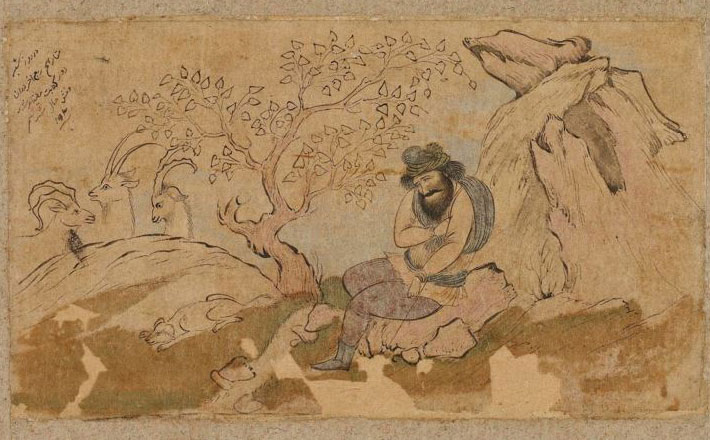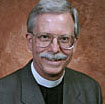Commentary on Revelation 7:9-17
When Revelation 7:9-17 is read as an isolated unit, much of its meaning is lost.
To grasp the passage’s fuller meaning we need to go to chapter 6, where the first six seals on the scroll are opened. After the sixth seal is opened (verse 12), the physical foundations of creation are rattled. Destruction reaches such a pitch that all people hide. Key is their question in 6:17. Now that the day of wrath has come, “‘Who is able to stand?’
When John the Seer reaches that point in his visions, he stops. The suffering and destruction of the first six seals are overwhelming, and so he introduces a break, a timeout that he uses to lift the vision of God’s people from the difficulties of the present to the glories of the future. In 7:1-8, the angels of God seal the 144,000. The sealing, with a likely reference to baptism, sustains the church on earth. The designation of twelve tribes times twelve thousand people per tribe envisions the church in this world as part of God’s army in battle with the powers of evil. The opening vision of chapter 7, then, is of the church militant.
The fulcrum on which the passage balances is the difference between verse 4 and verse 9. In verse 4 John “heard the number.” In verse 9 he “looked.” What he sees is a vast international, multi-racial, multi-lingual throng of people so great that no one could count it. Although scholars differ in their understanding of how the people in 7:1-8 relate to the people in 7:9-17, I think that in the latter verses we have the church in heaven, or what we sometimes call the church triumphant.
John gives us a preview of the way things are to be. The people he sees wear white robes and carry palm branches. The robe is an important piece of clothing in the Bible. It signals not only outward clothing, but reveals who the person is, what her or his status is. And so the prodigal son is given a new robe, not just so that he would have something clean to wear but as an indication of his restored place in the family (Luke 15:22). Believers, then, wear the white robe of purity, and they carry palm branches as signs of victory and joy following war.
The “crying out” of the multitude in 7:10 connects us with 6:10, where impatient martyrs resting under the throne of God also cry out–in that case for justice. 7:10 gives an answer, as the unnumbered throng praises God. The word salvation, for which they praise God and the Lamb, is indeed in Greek the word salvation, but that term can also be used for victory, which would be appropriate in this view of the final future.
In verses 11-12 heavenly beings join in the singing. As we might expect in Revelation, they use seven terms to praise God. The center one is often the most significant, and it is the word thanksgiving. We will see why.
In verses 13-14 we have a temporary reversal of the way apocalyptic literature usually functions. One of the heavenly beings asks John the meaning of the vision. John appropriately turns the question back to the elder, who as the heavenly being is the one to interpret. The NRSV, unfortunately, mistranslates his response. “These are they who have come out of the great ordeal,” should be translated as “these are they who are coming ….” The participle that means coming is present tense and refers to an ongoing action: those who are killed are still coming. Note that the church has not been “raptured” out (a non-biblical doctrine often foisted onto Revelation); the church suffers.
The martyrs, in one of John’s reversal of images, “washed their robes and made them white in the blood of the Lamb.” Any college freshman knows that washing something in blood (or red in general) does not turn something white. But here the blood of the Lamb purifies the martyrs and takes away their sin (see 1:5, 5:9, 12:11; Isaiah 1:18), and so their robes are white.
The preacher can easily skip over verses 15-17, but they contain great words of comfort. Believers stand before God’s throne and worship God. God, in turn, will shelter them. The word translated as shelter is the word that also is translated as dwell (21:3, e.g.). God’s presence, God’s shekinah in Old Testament terms, will remain with them. Old Testament associations lie behind almost every statement in the interpretation of the elder, especially Isaiah 49:10 and 25:8. In a world in which subsistence was the normal pattern of life, the vision of no more hunger or thirst communicated at a visceral level. Relief from the sun and from heat reflects life in the Middle East. Sunbathing among peasants was not a vacation activity! People in fact had to protect themselves from the sun, as I learned when I taught in Cairo, Egypt, in 2009.
In the final verse, John once more plays with language and images. It is the Lamb who will be the shepherd (also in 12:5, 19:15) who leads God’s people to the “springs of the water of life.” “And God will wipe away every tear from their eyes” (see also 21:1-4).
With that vision in their minds and hearts, those who listen to the reading of Revelation are ready to experience the breaking of the seventh and final seal–which is followed immediately by the next cycle of seven end-time woes, that of the trumpets (8:1-2). They continue their journey through John’s visions by having given thanks to the one who has saved them and who provides everything needed for life.
So who is able to stand? Those whom the Lamb has washed. With that word of encouragement, this persecuted minority–the first-century church–is able to move ahead, because they know where God is taking them. And today’s believers know the same.


April 25, 2010